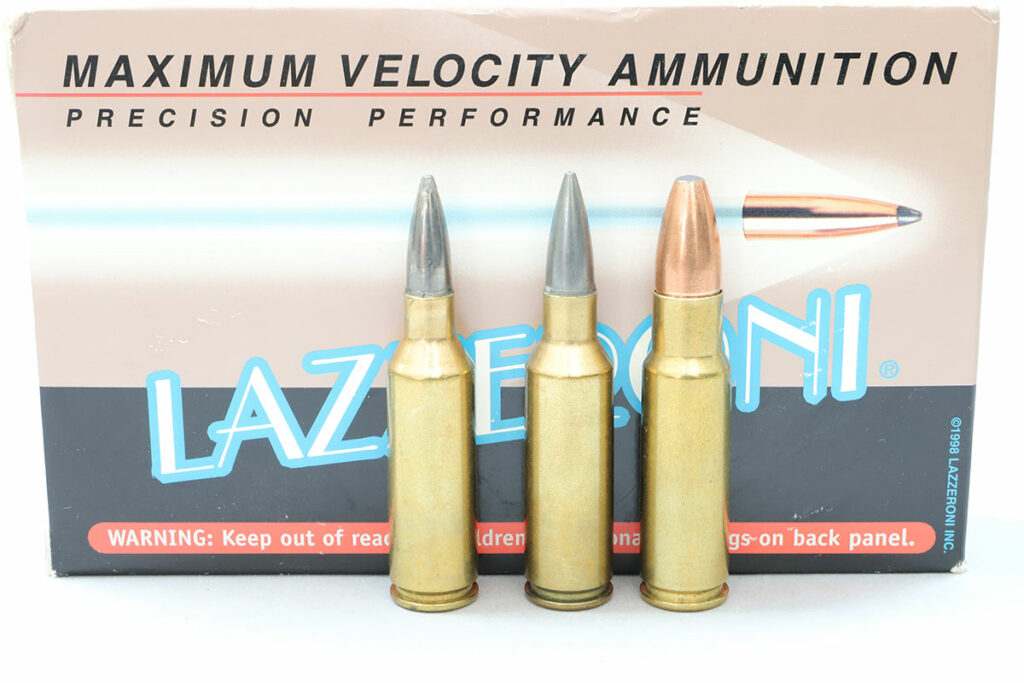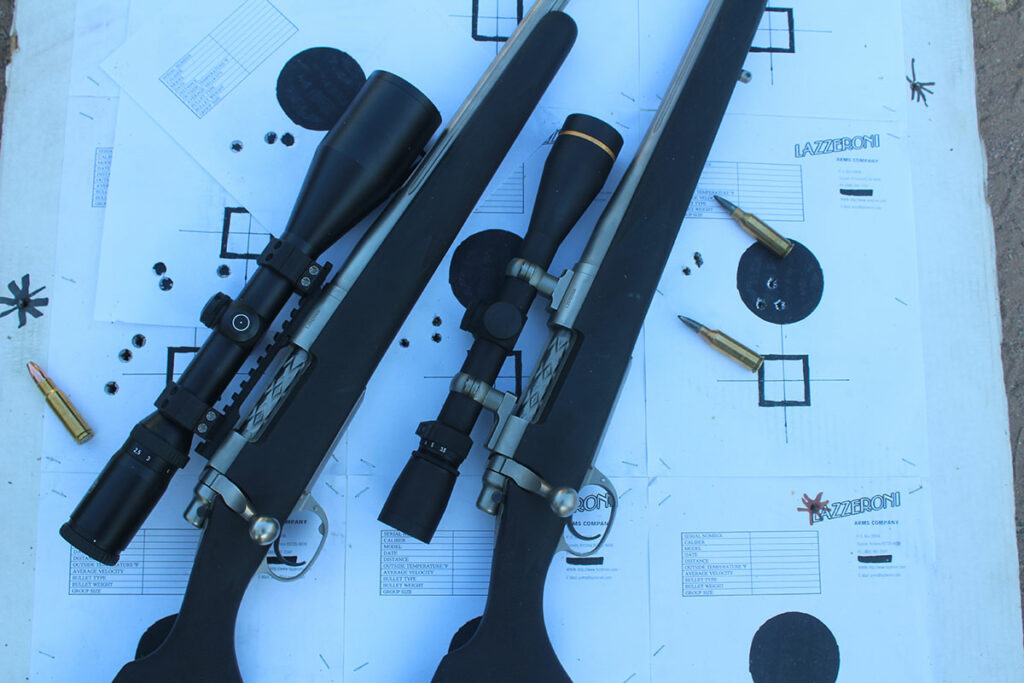BIGGEST, BADDEST, FASTEST SHORT MAGS — Part 1
Provided you’re a cartridge—and not looking at a mirror—short and fat are in. The technical advantages are genuine. Quicker and more uniform ignition because of better access to the primer flame and a more uniform burning curve. These are conducive to accuracy, but that’s hard to measure because quality of barrel and uniformity of ammunition. are much more important to accuracy than cartridge design.
There are physical advantages that can readily be seen. Because of better burn of propellant, there is an energy increase per grain of propellant. Also, because of more efficient burning, shorter, wider cartridges tend to produce full velocity in shorter barrels than cartridges with longer and relatively slimmer cases. From a hunter’s standpoint, the fat little fireplug-shaped cartridges we call short magnums also fit in shorter actions. These, in turn offer genuine advantages. Less overall gun weight, shorter and faster bolt throw, and shorter actions are more rigid, also conducive to accuracy.

None of this is new. Starting in 1998, in the space of a few years the market was asked to embrace about 11 short (and short-action, super-short and compact) magnums from major manufacturers. I’ve messed with all of them and all do what they are supposed to do. However, to my thinking this was a whole bunch all at once. Some have already suffered an early demise. We, the jury, are still out on others. Without question, the most popular of the bunch has been the .300 Winchester Short Magnum (WSM), probably followed by the .270 WSM.
Pre-dating all of these by several years, and still caliber by caliber, the fastest in their class, are the short magnums from Lazzeroni Arms in Tucson, Arizona. Starting about 1990, lifelong hunter and handloader John Lazzeroni wildcatted two distinct families of cartridges, long and short. All are based on rimless, large-diameter cases with minimal body taper and shoulder headspacing.
Most of Lazzeroni’s long magnums use a (nominally) 2.8-inch case, same as the .375 H&H family, but wider, with a .580-inch rim and base. Exterior dimensions are similar to the .416 Rigby case, but Lazzeroni has retained all his cartridges as proprietaries, using brass made to his specifications that is heavier, with thicker walls.
I’ve known John Lazzeroni pretty much since he went “commercial” with Lazzeroni Arms. I’ve targeted and chronographed most of his cartridges and hunted with several, both long and short. I’ll admit, there was a time when I wondered if “Lazz” might be a dangerous crackpot. Zealot, yes, crackpot, no. His rifles are well-made and accurate, chronographs consistently bear out his velocity claims and I’ve never seen pressure signs from Lazzeroni ammo. Factory loads are held to a maximum pressure of 66,500 psi, which is a normal SAAMI pressure specification for modern magnum cartridges.

Over the years, I’ve often compared Lazz to Roy Weatherby, also a passionate zealot who gave us some great cartridges. Both Lazzeroni and Weatherby experimented with a wide variety of case dimensions and bullet diameters. Many of these, for various reasons, never made it into their respective product lines.
Today, Lazzeroni’s production long magnum line is limited to six bullet diameters, from .257 to .416, all the fastest in their class. For 2020, he has added short-magnum Mountain-Lite and short-action dangerous game versions to his L2012 rifle lineup and is focusing on six bullet diameters in short magnum cartridges: .284, .308, .338, .375, .416. and .475.
WHAT’S IN A NAME?
Whimsical cartridge names are not unusual (.22 Hornet, .220 Swift, .350 Legend, etc.). Invent a cartridge and you can call it whatever you want. The long magnum line includes Firebird, Warbird, Titan and Saturn. However, it used to drive me bonkers that Lazz uses literal metric diameters. For instance, his 7.21 (.284) Firebird is what we think of as a 7mm; his 7.82 (.308) Warbird is what we think of as a .30-caliber.
So, I invite you to do a little exercise. Google convert inches to millimeters. When the screen comes up, enter .284, which is the English diameter of all 7mm bullets. The result will be 7.2136mm. Round to two decimals, and you have 7.21. That took me less than ten seconds, so do it again and enter .308, the diameter of our .30-caliber bullets. The result will be 7.8232, the source of Lazzeroni’s 7.82 for his cartridges, long and short, that use .308-inch bullets.
In America, we often round cartridge designations up and down, but we always use thousandths of an inch for bullet diameters. In both England and Europe, they sometimes use the rifling land-to-land dimension, which is smaller than actual bullet diameter. So, unfamiliar they might be, but Lazzeroni’s metric caliber designations are precisely matched to actual bullet diameters. And, in all things relative to his cartridges and rifles, Lazz is a precise guy.
LAZZERONI SHORT MAGNUMS
We Americans love our .30-calibers and the long, fast and powerful 7.82 (.308) Warbird is probably the flagship of the Lazzeroni line. His short magnum family uses this big case, but with three-fourths of an inch (.750-inch) cut out of the middle. The results are fireplug-shaped cases at just over two inches and very fat for their length, thus efficient and very fast for their size.
The six production short magnums are: 7.21 (.284) Tomahawk; 7.82 (.308) Patriot; 8.59 (.338) Galaxy; 9.53 (.375) Hellcat; 10.57 (.416) Maverick; and 12.04 (.475) Lilmufu. We can all play with ballistics charts; it depends on who is doing the loading and which loads we’re comparing.
However: The Tomahawk consistently exceeds the 7mm Remington Magnum; the Patriot exceeds the .300 Winchester Magnum; the Galaxy exceeds the .338 Winchester Magnum; the Hellcat equals the .375 H&H; the Maverick equals the .416 Remington Magnum; and the Lilmufu .475 comes very close to the .470 Nitro Express, all in short actions.

Without question there are other wildcat and proprietary short cartridges, but no production short magnum comes close. This does come at a cost. The Lazzeroni case requires a larger bolt face, and not all bolt actions can accommodate (and properly feed) cartridges of this width. Lazzeroni, of course, designed his L2012 action for his cartridges.
Numerous other actions will work and both Sako and Savage have done runs of production rifles in Lazzeroni cartridges. The short magnums are true short magnums, scaled to fit a short-action Remington M700. As true proprietary cartridges, Lazzeroni remains essentially the single source for loaded ammo and cases, but reloading dies, loading data and chamber reamers are readily available, and of course bullets are standard diameters.–Craig Boddington

